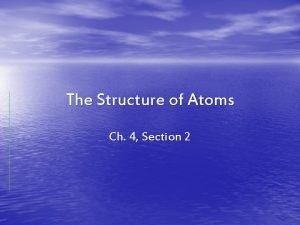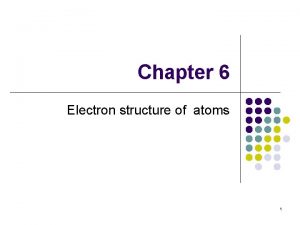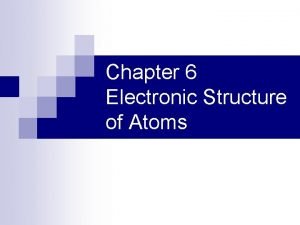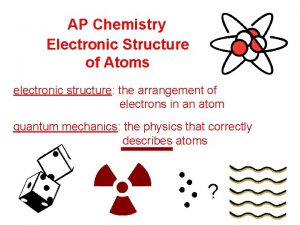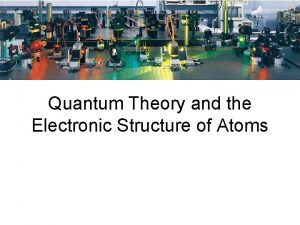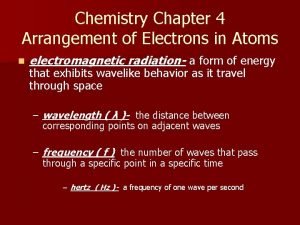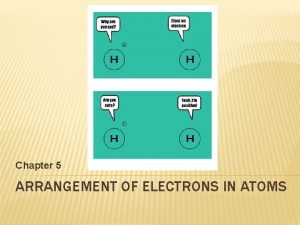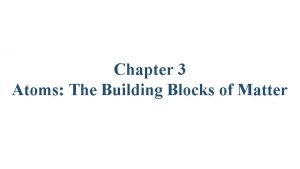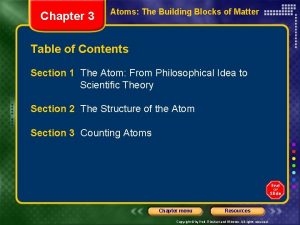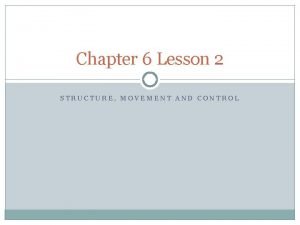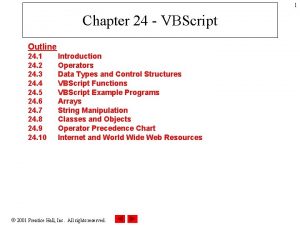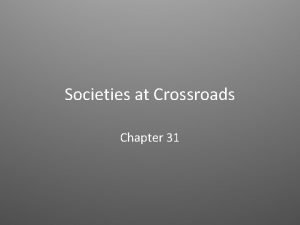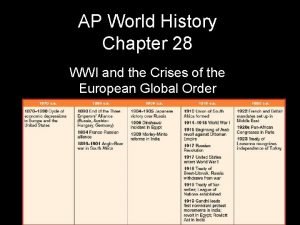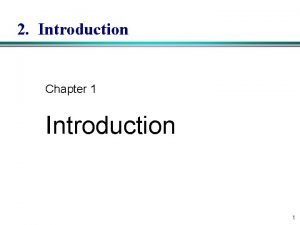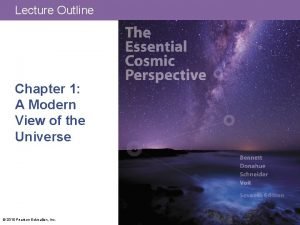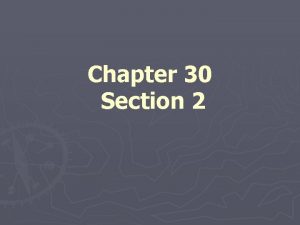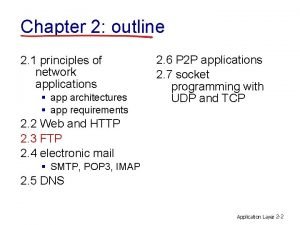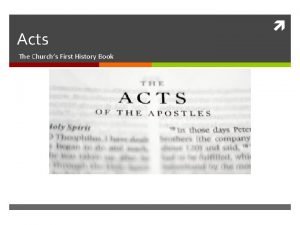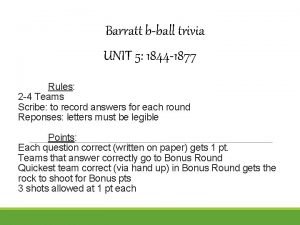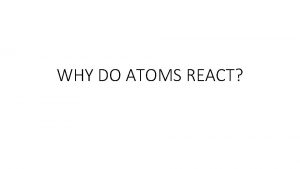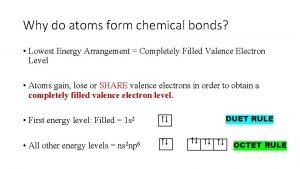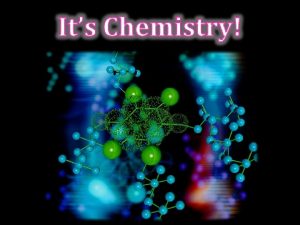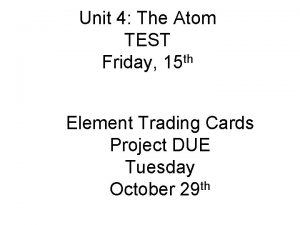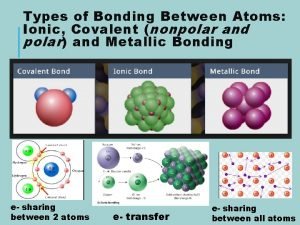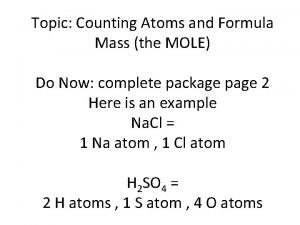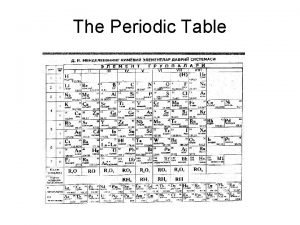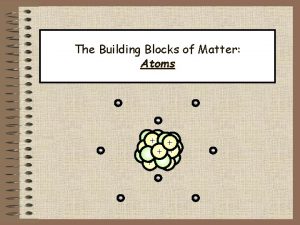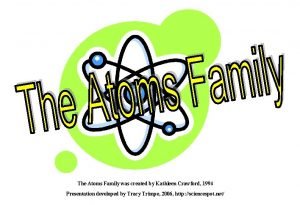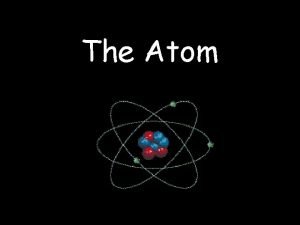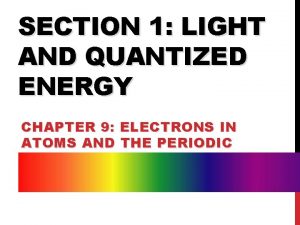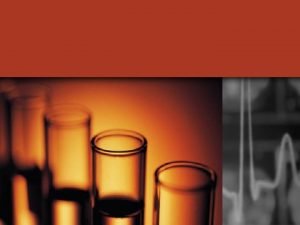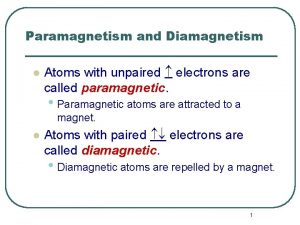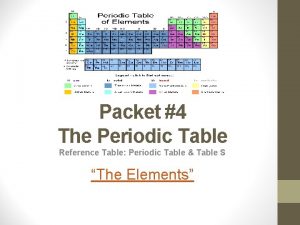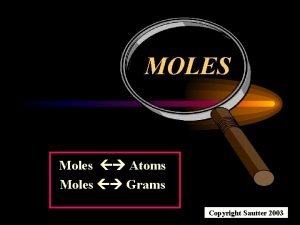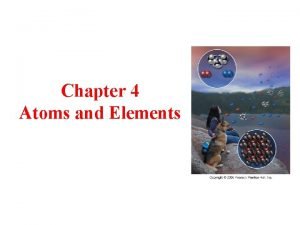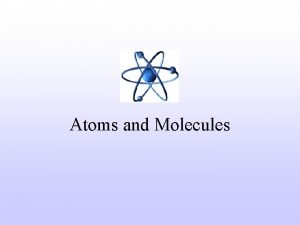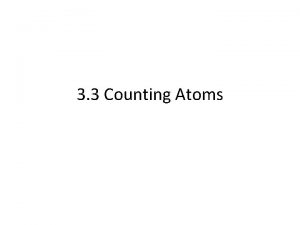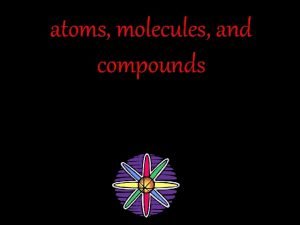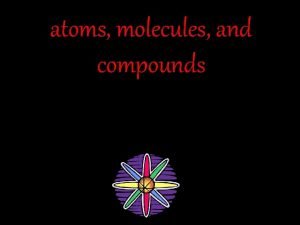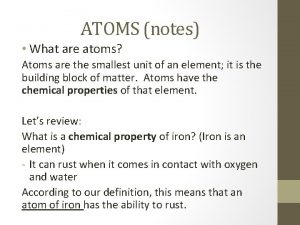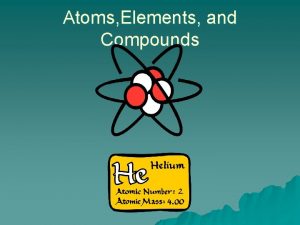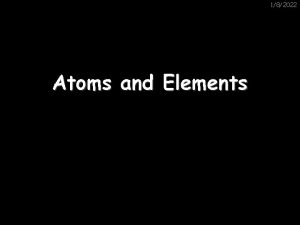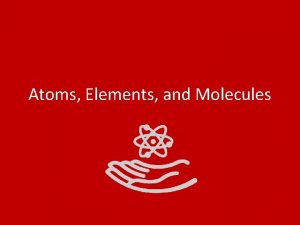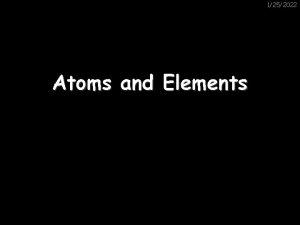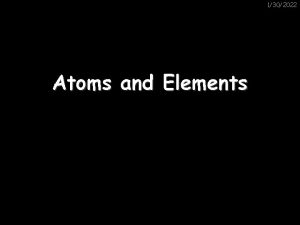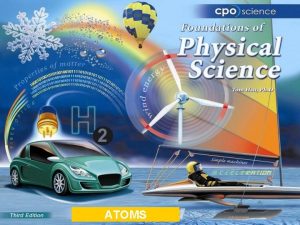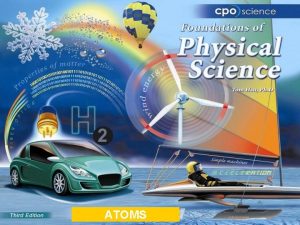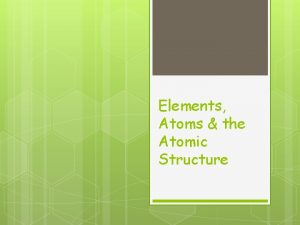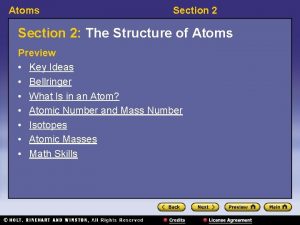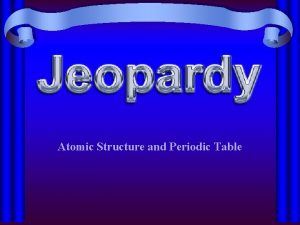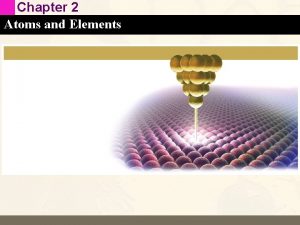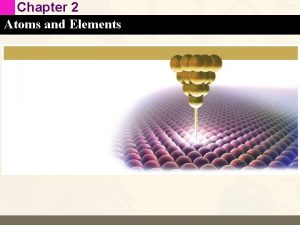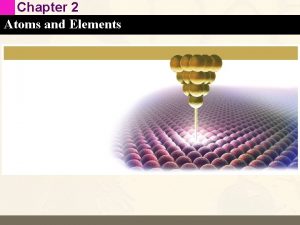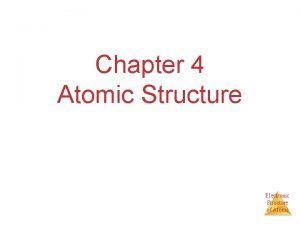4 The Structure of Atoms Chapter Outline 1

































































































- Slides: 97

4 The Structure of Atoms

Chapter Outline 1. 2. 3. 4. 5. 6. 7. 8. Subatomic Particles 次原子粒子 Fundamental Particles基本粒子 The Discovery of Electrons 電子的發現 Canal Rays and Protons 陽極射線與質子 Rutherford and the Nuclear Atom 拉塞福與核型原子 Atomic Number原子序 Neutrons 中子 Mass Number and Isotopes 質量數和同位素 Mass spectrometry and Isotopic Abundance 質譜儀和 同位素豐量 9. The Atomic Weight Scale and Atomic Weights化學原子 量單位和原子量 10. The Periodic Table: Metals, Nonmetals, and Metalloids 周期表: 金屬, 非金屬和類金屬 2

Chapter Outline The Electronic Structures of Atoms 原子的電子構造 11. Electromagnetic radiation電磁輻射 12. The Photoelectric Effect 光電效應 13. Atomic Spectra and the Bohr Atom 原子光譜和波耳原子 模型 14. The Wave Nature of the Electron 電子具波的性質 15. The Quantum Mechanical Picture of the Atom 原子的量 子力學架構 16. Quantum Numbers 量子數 17. Atomic Orbitals 原子軌道 18. Electron Configurations 電子組態 19. The Periodic Table and Electron Configurations 週期表 與電子組態 20. Paramagnetism and Diamagnetism 順磁性及逆磁性 3

Fundamental Particles基本粒子 • Three fundamental particles make up atoms. The following table lists these particles together with their masses and their charges. Table 4 -1 Fundamental Particles of Matter Mass (amu) Particles Charge Electron 電子(e-) 0. 00054858 -1 Proton 質子 (p, p+) 1. 0073 +1 Neutron 中子 (n, n 0) 1. 0087 0 4

The Discovery of Electrons • Humphrey Davy in the early 1800’s passed electricity through compounds and noted: –that the compounds decomposed into elements. –concluded that compounds are held together by electrical forces電力. • Michael Faraday in 1832 -1833 realized that the amount of reaction that occurs during electrolysis電解is proportional to the electrical current passed through the compounds. 法拉第 電學之父 戴維 無機化學之父 第一、作個人的筆記 第二、持續的上課 第三、有讀書的同伴 第四、成立讀書會 第五、學習仔細觀察和精確的用字 5

The Discovery of Electrons • Cathode Ray Tubes 陰極射線管experiments performed in the late 1800’s & early 1900’s. –Consist of two electrodes 電極 sealed in a glass tube containing a gas at very low pressure. –When a voltage is applied to the cathodes a glow Collimator準直儀 discharge is emitted. 燈絲加熱陰極發射電子,加速和聚焦後形成 電子束,陰性電子束會受到螢光屏的陽極吸 引而正確投射 把點光源發出的發散光或 其他輻射變成平行光束的器件 6

The Discovery of Electrons • These “rays” are emitted from cathode (- end) and travel to anode (+ end). –Cathode Rays must be negatively charged! • J. J. Thomson modified the cathode ray tube experiments in 1897 by adding two adjustable voltage electrodes. –Studied the amount that the cathode ray beam was deflected by additional electric field. 7


The Discovery of Electrons • Thomson used his modification to measure the charge to mass ratio of electrons. Charge to mass ratio 基本粒子的荷質比 e/m = -1. 75881 x 108 coulomb/g of e- • Thomson named the cathode rays electrons. • Thomson is considered to be the “discoverer of electrons”. • TV sets and computer screens are cathode ray tubes. The coulomb (C)庫侖is the standard unit of quantity of electric charge. It is defined as the quantity of electricity transported in one second by a current of one ampere. 9

The Discovery of Electrons • Robert A. Millikan won the 1 st American Nobel Prize in 1923 for his famous oil-drop experiment 油滴實驗 • In 1909 Millikan determined the charge and mass of the electron 10

The Discovery of Electrons • Millikan determined that the charge on a single electron = 1. 60218 x 10 -19 coulomb. • Using Thomson’s charge to mass ratio we get that the mass of one electron is 9. 11 x 10 -28 g. –e/m = -1. 75881 x 108 coulomb – e = -1. 60218 x 10 -19 coulomb –Thus m = 9. 10940 x 10 -28 g 11

Canal Rays陽極射線and Protons 質子 • Eugene Goldstein noted streams of positively charged particles in cathode rays in 1886. – Particles move in opposite direction of cathode rays. – Called “Canal Rays” because they passed through holes (channels or canals) drilled through the negative electrode. • Canal rays must be positive. – Goldstein postulated the existence of a positive fundamental Atom cation++ eparticle called the “proton”. 陽極 陰極 Canal rays particles have e/m ratios many smaller than those of electrons because of their 12 much greater masses

Rutherford拉塞福and the Nuclear Atom 核型原子 How are these charge distributed? • Ernest Rutherford directed Hans Geiger蓋革and Ernst Marsden’s馬斯頓experiment in 1910. – - particle scattering from thin Au foils –Gave us the basic picture of the atom’s structure. –散射 粒子到金箔並且觀察到大角度的散射,提出了原 子有很小、密度大且帶正電的核 Undeflected α particles Source of narrow beam of fast -moving a particle (positive charge) Deflected particles Zn. S fluorescent screen 13

Rutherford and the Nuclear Atom In 1912 Rutherford decoded the -particle scattering information –Explanation involved a nuclear atom with electrons surrounding the nucleus 14

Rutherford and the Nuclear Atom Rutherford’s major conclusions from the -particle scattering experiment 1. The atom is mostly empty space. 2. It contains a very small, dense center called the nucleus. 3. Nearly all of the atom’s mass is in the nucleus. 4. The nuclear diameter is 1/10, 000 to 1/100, 000 times less than atom’s radius. 15

Rutherford and the Nuclear Atom • Because the atom’s mass is contained in such a small volume: –The nuclear density is 1015 g/m. L. –This is equivalent to 3. 72 x 109 tons/in 3. –Density inside the nucleus is almost the same as a neutron star’s density. Rutherford Model of the atom: Atoms consist of very small, very dense positively charged nuclei surrounded by clouds of electrons at relatively large distances from the nuclei 16

Atomic Number原子序 • The atomic number is equal to the number of protons in the nucleus –Sometimes given the symbol Z –On the periodic chart Z is the uppermost number in each element’s box • In 1913 H. G. J. Moseley realized that the atomic number determines the element –The elements differ from each other by the number of protons in the nucleus. –The number of electrons in a neutral atom is also equal to the atomic number. 17

Neutrons 中子 • James Chadwick 查兌克 in 1932 analyzed the results of -particle scattering on thin be films. • Chadwick recognized existence of massive neutral particles which he called neutrons. –Chadwick discovered the neutron. Atoms consist of very small, very dense positively charged nuclei surrounded by clouds of electrons at relatively large distances from the nuclei. All nuclei contain protons; nuclei of all atoms except the common form of hydrogen also contain neutrons 18

Mass Number質量數 and Isotopes 同位數 • Mass number is given the symbol A. • A is the sum of the number of protons and neutrons. –Atomic number Z = proton number N = neutron number –Mass number A = Z + N • A common symbolism used to show mass and proton numbers is A 12 40 197 E for example C Ca Z 6 79 Au 20 • Can be shortened to this symbolism. 14 N 63 Cu 107 Ag 19

Mass Number and Isotopes • Isotopes are atoms of the same element but with different neutron numbers –Isotopes have different masses and A values but are the same element • Display very similar chemical properties • One example of an isotopic series is the hydrogen isotopes the most common hydrogen . a radioactive hydrogen isotope 20

Mass Number and Isotopes • The stable oxygen isotopes provide another example. • 16 O is the most abundant stable O isotope. –How many protons and neutrons are in 16 O? 8 protons and 8 neutrons • 17 O is the least abundant stable O isotope. ¯ How many protons and neutrons are in 17 O? 8 protons and 9 neutrons • 18 O is the second most abundant stable O isotope. ¯ How many protons and neutrons in 18 O? 8 protons and 10 neutrons 21

Example 4 -1 Determination of Atomic Makeup Determine the number of protons, neutrons, and electrons in each of the following species. Are the members within each pair isotopes? 63 (a) (b) 35 37 Cu and 65 Cu 17 35 17 Cl and 17 Cl 29 29 (a) Cl Atomic number=17, 17 protons/nucleus mass number =35 18 neutrons Because no charge is indicated: 17 electrons 37 17 Cl 17 protons, 20 neutrons, and 17 electrons These are isotopes of the same element (b) 63 29 Cu 29 protons, 34 neutrons, and 29 electrons 65 29 Cu 29 protons, 36 neutrons, and 29 electrons These are isotopes of the same element Exercise 18, 20 22

Mass Spectrometry質譜儀and Isotopic Abundances • Francis Aston devised the first mass spectrometer. 英 國物理學家,因研製質譜儀並用以準確測量原子及分子質量以及發現大 量核素,獲 1922年諾貝爾化學獎 • 質譜儀(mass spectrometry, MS)是以熱電子撞擊氣體 分子,使產生碎片及離子,再經磁場分離,依據質 荷比之測量,來決定分子質量的技術。 • There are four factors which determine a particle’s path in the mass spectrometer. 1. accelerating voltage – 電場強度 2. magnetic field strength – 磁場強度 3. masses of particles – 物質質量 4. charge on particles – 物質電荷 23


Mass Spectrometry and Isotopic Abundances + • Mass spectrum of Ne ions shown below. –How scientists determine the masses and abundances of the isotopes of an element. 組成比例 Isotope abundances: the relative amounts of the isotopes 同位素豐量 (isotopic abundance):為某種同位素在此元素之各種同位素 中所占的原子百分比。 25

A modern mass spectrum 26


The Atomic Weight Scale原子量單位 and Atomic Weights原子量 • If we define the mass of 12 C as exactly 12 atomic mass units (amu)原子質量單位, then it is possible to establish a relative weight scale for atoms. – 1 amu = (1/12) mass of 12 C by definition –What is the mass of an amu in grams? 28

The Atomic Weight Scale and Atomic Weights A Z E Atomic number Z = proton number N = neutron number Mass number A = Z + N • The atomic number Z =proton number in the nucleus = electrons (in a neutral atom) • The Mass Number A = proton number +neutron number • The atomic weight of an element is the weighted average of the masses of its stable isotopes 29

The Atomic Weight Scale and Atomic Weights • Example 4 -2: Naturally occurring Cu consists of 2 isotopes. It is 69. 1% 63 Cu with a mass of 62. 9 amu, and 30. 9% 65 Cu, which has a mass of 64. 9 amu. Calculate the atomic weight of Cu to one decimal place. 63 Cu isotope 65 Cu isotope Atomic weight= (0. 691)x(62. 9 amu) + (0. 309)x(64. 9 amu) =63. 5 amu for copper 30

The Atomic Weight Scale and Atomic Weights • Example 4 -3: Naturally occurring chromium consists of four isotopes. It is 4. 31% 2450 Cr, mass = 49. 946 amu, 83. 76% 52 Cr, mass = 51. 941 amu, 9. 55% 53 Cr, mass = 52. 941 amu, 24 24 54 and 2. 38% 24 Cr, mass = 53. 939 amu. Calculate the atomic weight of chromium. Atomic weight= (0. 6431 x 49. 946 amu)+(0. 8376 x 51. 941 amu) +(0. 0955 x 52. 941 amu)+(0. 0238 x 53. 939 amu) =51. 998 amu for chromium 31

The Atomic Weight Scale and Atomic Weights • Example 4 -4: The atomic weight of boron is 10. 811 amu. The masses of the two naturally occurring isotopes 510 B and 511 B, are 10. 013 and 11. 009 amu, respectively. Calculate the fraction and percentage of each isotope. Let the 105 B fraction is x 11. 811 amu = (x x 10. 013 amu)+((1 -x ) x 11. 009 amu) =(10. 013 x +11. 009 -11. 009 x)amu (11. 811 -11. 009) amu=(10. 013 -11. 009) x amu x =0. 199 % abundance of 105 B is 19. 1% % abundance of 115 B = 100%-19. 1% = 80. 9% Textbook example 4 -2 and 4 -3 p 132 -133 32

The Atomic Weight Scale and Atomic Weights Example 4 -2 Calculation of Atomic Weight Three isotopes of magnesium occur in nature. Their abundances an masses, determined by mass spectrometry, are listed in the following table. Use this information to calculate the atomic weight of magnesium. Isotope %Abundance Mass (amu) 24 Mg 78. 99 23. 98504 25 Mg 10. 00 24. 98584 26 Mg 11. 01 25. 98259 Atomic weight = 0. 7899 x (23. 98504 amu) + 0. 1000 x (24. 98584 amu) + 0. 1101 x (25. 98259 amu) =18. 946 amu+2. 4986 amu+2. 8607 amu = 24. 30 amu Exercise 28, 30 33

The Atomic Weight Scale and Atomic Weights Example 4 -3 Calculation of Iostope Abundance The atomic weight of gallium is 69. 72 amu. The masses of the naturally occurring isotopes are 69. 9257 amu for 69 Ga and 70. 9249 amu for 71 Ga. Calculate the percent abundance of each isotope. Let x =fraction of 69 Ga Then (1 -x)= fraction of 71 Ga x x (69. 9257 amu) + (1 -x) x (70. 9249 amu) = 69. 72 amu 68. 9257 x + 70. 9249 -70. 9249 x =69. 72 -1. 992 x = -1. 20 x = 0. 6 x = fraction of 69 Ga 60. 00% 69 Ga (1 -x )= 0. 4=fraction of 71 Ga 40. 00% 71 Ga Exercise 32 34

The Periodic Table: Metals, Nonmetals, and Metalloids • 1869 - Mendeleev & Meyer –Discovered the periodic law • The properties of the elements are periodic functions of their atomic numbers. 35

The Periodic Table: Metals, Nonmetals, and Metalloids 周期表: 金屬、非金屬、類金屬 • Groups or families (族) –Vertical group of elements on periodic table –Similar chemical and physical properties 鉻 鉬 鎢 36


The Periodic Table: Metals, Nonmetals, and Metalloids • Period (週期) –Horizontal group of elements on periodic table –Transition from metals to nonmetals –Increasing atomic number原子序 鋰 鈹 硼 碳 氮 氧 氟 氖 38


The Periodic Table: Metals, Nonmetals, and Metalloids Table 4 -6 Some physical properties of metals • High electrical conductivity that decreases with increasing temperature 導電性 ( 溫度升高導電性降低) • High Thermal conductivity導熱性 • Metallic gray or silver luster 具金屬光澤 • Almost all are solids • Malleable (can be hammered into sheets) 可塑性 • Ductile (can be drawn into wires)具展延性 Table 4 -6 Some physical properties of nonmetals • Poor electrical conductivity (except carbon) • Good heat insulators (except carbon) • No metallic luster • Solid, liquid or gases • Brittle in solid state • Nonductile 40

The Periodic Table: Metals, Nonmetals, and Metalloids Table 4 -7 Some chemical properties of metals • Outer shells contain few electrons—three or fewer • Form cations by losing electrons (易失電子而帶正電) • Form ionic compounds with nonmetals 與非金屬形成離子化合物 • Solid state characterized by metallic bonding 金屬鍵結 Table 4 -7 Some chemical properties of nonmetals • Outer shells contain four or more electrons • Form anion by gating electrons (易得電子而帶負電) • Form ionic compounds with metals and molecular (covalent) other compounds with nonmetals • Covalently bonded molecules 共價分子; noble gases are monatomic 41

The Periodic Table: Metals, Nonmetals, and Metalloids Metallic character increases from top to bottom and decreases from left to right with respect to position in the periodic table Nonmetallic character decreases from top to bottom and increases from left to right with respect to position in the periodic table 42

The Periodic Table: Metals, Nonmetals, and Metalloids Metalloid 類金屬 –Some properties that are characteristic of both metals and nonmetals –Some act as semiconductors半導體: such as silicon矽, germanium鍺, antimony銻 • insulators at lower temperature • Become conductors at higher temperature –Aluminum is the least metallic of the metals and is sometimes classified as a metalloid • It is metallic in appearance and an excellent conductor of electricity 43

The Periodic Table: Metals, Nonmetals, and Metalloids • Group IA metals (Alkali metals 鹼金屬) –Li, Na, K, Rb, Cs, Fr • One example of a periodic trend –The reactions with water of Li, Na, & K 44

The Periodic Table: Metals, Nonmetals, and Metalloids • Group IIA metals –alkaline earth metals 鹼土金屬 • Be, Mg, Ca, Sr, Ba, Ra 45

The Periodic Table: Metals, Nonmetals, and Metalloids • Group VIIA nonmetals –Halogens 鹵素 –F, Cl, Br, I, At 46

The Periodic Table: Metals, Nonmetals, and Metalloids • Group VIA nonmetals –O, S, Se, Te 47

The Periodic Table: Metals, Nonmetals, and Metalloids • Group 8 A nonmetals –noble, inert or rare gases –He, Ne, Ar, Kr, Xe, Rn 48

Electromagnetic Radiation 電磁輻射 • 以電磁波方式在自由空間或實物媒質中傳播的能量,例如 無線電波、可見光和γ射線。 • The wavelength 波長of electromagnetic radiation has the wavelength symbol . –Wavelength is the distance from the top (crest) of one wave to the top of the next wave. • Measured in units of distance such as m, cm, Å. – 1 Å = 1 x 10 -10 m = 1 x 10 -8 cm • The frequency 頻率of electromagnetic radiation has the frequency symbol . –Frequency is the number of crests or troughs that pass a given point per second. • Measured in units of 1/time - s-1 49


Electromagnetic Radiation For electromagnetic radiation the velocity is 3. 00 x 108 m/s= c = Energy increases wavelength increases 可見光譜 頻率 7. 5 x 1014 波長 4000 Visible spectrum 4 x 1014 7000 Å 51

Electromagnetic Radiation • Example 4 -5: What is the frequency of green light of wavelength 5200 Å? = c �= 5200 x 1 x 10 -10 (m)=5. 200 x 10 -7 m c = 3. 00 x 108 m/s = 5. 200 x 10 -7 m = 5. 77 x 1014 s-1 52

The Photoelectric Effect 光電效應 • Light can strike the surface of some metals causing an electron to be ejected. 頻率夠高之光子與金屬原子中的電子碰撞,可以將電子撞離原子 53

Atomic Spectra and the Bohr Atom 原子光譜和波耳原子模型 電子只能存在某些特殊的軌道上才是穩定的,在 這些軌道上不會放射出電磁波,因此電子也不會 損失能量, 在這個假設下,原子的激發光譜自然 而然也是不連續的 • Energy is quantized 能量可被量化 • Each orbit corresponds to a definite energy level for the electron 電子軌道具有特定的能階 • When an electron is promoted form a lower energy level to a higher one, it absorbs a definite amount of energy 當電子從低能階移到高能階時, 必吸收能量 54


The Quantum Mechanical Picture of the Atom Basic Postulates of Quantum Theory 1. Atoms and molecules can exist only in certain energy states. In each energy state, the atom or molecule has a definite energy. When an atom or molecule changes its energy state, it must emit or absorb just enough energy to bring it to the new energy state (the quantum condition). 原子或分子存 在特定能階 56

The Quantum Mechanical Picture of the Atom 2. Atoms or molecules emit or absorb radiation (light) as they change their energies. The frequency of the light emitted or absorbed is related to the energy change by a simple equation. 當原子或分子改變能量時, 必放出或 吸收輻射能 57

The Quantum Mechanical Picture of the Atom 3. The allowed energy states of atoms and molecules can be described by sets of numbers called quantum numbers 量子數. 以數字描述原子或分 子的能量狀態稱之為量子數 – Quantum numbers are the solutions of the Schrodinger, Heisenberg & Dirac equations. – Four quantum numbers are necessary to describe energy states of electrons in atoms. 有4種量子數 58


Quantum Numbers • The angular momentum角動量quantum number or orbital quantum number軌道量子數 has the symbol . = 0, 1, 2, 3, 4, 5, . . . . (n-1) = s, p, d, f, g, h, . . . . (n-1) • designates a sublevel (副殼層), tells us the shape of the orbitals. 軌道的形狀 • These orbitals are the volume around the atom that the electrons occupy 90 -95% of the time. This is one of the places where Heisenberg’s Uncertainty principle comes into play. 60


Quantum Numbers • Orbital within a given subshell differ in their orientation 方向 in space, but not in their energies. • The symbol for the magnetic quantum number 磁量 子數is m. m = - , (- + 1), (- +2), . . . 0, . . . . , ( -2), ( -1), • If = 0 (or an s orbital), then m = 0. –Notice that there is only 1 value of m. This implies that there is one s orbital per n value. n 1 • If = 1 (or a p orbital), then m = -1, 0, +1. –There are 3 values of m. Thus there are three p orbitals per n value. n 2 62

Quantum Numbers • If = 2 (or a d orbital), then m = -2, -1, 0, +1, +2. –There are 5 values of m. Thus there are five d orbitals per n value. n 3 • If = 3 (or an f orbital), then m = -3, -2, -1, 0, +1, +2, +3. –There are 7 values of m. Thus there are seven f orbitals per n value, n 4 • Theoretically, this series continues on to g, h, i, etc. orbitals. –Atoms that have been discovered or made up to this point in time only have electrons in s, p, d, or f orbitals in their ground state configurations. 63

Quantum Numbers • The last quantum number is the spin quantum number自旋磁量子數, ms. • The spin quantum number only has two possible values. ms = +1/2 or -1/2 • This quantum number tells us the spin and orientation of the magnetic field of the electrons 電子的磁場的旋轉方向. • Wolfgang Pauli in 1925 discovered the Exclusion Principle 包利不相容原理. –No two electrons in an atom can have the same set of 4 quantum numbers. 64

65

Atomic Orbitals • Atomic orbitals are regions of space where the probability of finding an electron about an atom is highest. • s orbital properties: –There is one s orbital per n level. – = 0 1 value of m • s orbitals are spherically symmetric. s副殼層只有一個軌域,稱為s軌域,其電 子在空間出現機率為球形,即與原子核等 距離的位置(球面),電子出現的機率相同。 66

Atomic Orbitals • p orbital properties: –The first p orbitals appear in the n = 2 shell. • p orbitals are peanut or dumbbell shaped volumes. 啞鈴狀 –They are directed along the axes of a Cartesian coordinate system. • There are 3 p orbitals per n level. –The three orbitals are named px, py, pz. –They have an = 1. –m =-1, 0, +1 3 values of m 67


Atomic Orbitals • d orbital properties: –The first d orbitals appear in the n = 3 shell. • The five d orbitals have two different shapes: – 4 are clover leaf shaped. – 1 is peanut shaped with a doughnut around it. –The orbitals lie directly on the Cartesian axes or are rotated 45 o from the axes. • There are 5 d orbitals per n level. –The five orbitals are named – dxy, dyz, dx 2 -y 2, dz 2 –They have an = 2. –m = -2, -1, 0, +1, +2 5 values of m 69

Atomic Orbitals • d orbital shapes 70

Atomic Orbitals • f orbital properties: –The first f orbitals appear in the n = 4 shell. • The f orbitals have the most complex shapes. • There are seven f orbitals per n level. –The f orbitals have complicated names. –They have an = 3 –m = -3, -2, -1, 0, +1, +2, +3 7 values of m –The f orbitals have important effects in the lanthanide and actinide elements. 71

Atomic Orbitals • f orbital shapes 72

• In any atom, all orbitals with the same principal quantum number n are similar in size. 具相同主量 子數n, 其原子大小相當 • In an atom, larger values of n correspond to larger orbital size. (n值越大, 軌域 越大) • Each orbital with a given n value becomes smaller as nuclear charge increase (在 相同n值時, 當核電荷增加時, 軌域越小) 73

Atomic Orbitals • Spin quantum number自旋磁量子數effects: –Every orbital can hold up to two electrons. • Consequence of the Pauli Exclusion Principle. –The two electrons are designated as having one spin up and one spin down� • Spin describes the direction of the electron’s magnetic fields. Electron spin. The attraction due to their opposite magnetic fields helps to overcome the repulsion of their like charges. Two electrons occupy the same region 74

Paramagnetism順磁性and Diamagnetism反磁性 • Unpaired electrons have their spins aligned or –This increases the magnetic field of the atom. –Atoms with unpaired electrons are called paramagnetic. –Paramagnetic atoms are attracted to a magnet. • Paired electrons have their spins unaligned . –Paired electrons have no net magnetic field. –Atoms with paired electrons are called diamagnetic –Diamagnetic atoms are repelled by a magnet. 75

Paramagnetism and Diamagnetism • Because two electrons in the same orbital must be paired, it is possible to calculate the number of orbitals and the number of electrons in each n shell. • The number of orbitals per n level is given by n 2. • The maximum number of electrons per n level is 2 n 2. – The value is 2 n 2 because of the two paired electrons. Shell n Number of subshells Per shell n Number of Atomic Orbitals n 2 Maximun Number Of Electrons 2 n 2 1 1 1(1 s) 2 2 2 4 (2 s, 2 px, 2 py, 2 pz) 8 3 3 9 (3 s, three 3 p’s, five 3 d’s ) 18 4 4 16 32 5 5 25 50 76


構築原理(aufbau principle) • Each atom is “built up” by 1. Adding the appropriate numbers of protons and neutrons in the nucleus as specified by the atomic number and the mass number 2. Adding the necessary number of electrons into orbitals in the way that gives the lowest total energy for the atom • 在不考慮原子核內中子數目,元素原子的建構方式為依序 在原子核內加入一個質子,同時在核外加入一個電子形成 • 原子內質子與電子數相同,為電中性;原子核內質子數, 稱為原子序。原子序不同元素,性質不同。 • 電子先填入低能量軌域,然後依序往高能量軌域填入。 78

• The largest energy gap is between 1 s and 2 s orbitals • the energies of orbitals are generally closer together at higher energies. • The gap between np and (n+1)s is fairly high 2 p 3 s ; 3 p 4 s • The gap between (n-1)d and ns is quite small 3 d 4 s • The gap between (n-2)f and ns is even smaller. 4 f 6 s Fig 5 -29 The usual order of filling of the orbitals of an atom. 79



82



Row 2. Elements of atomic number 3 through 10 occupy the second period in the periodic table Atomic number 3 4 5 6 7 8 9 10 • Hund’s rule tells us that the electrons will fill the p orbitals by placing electrons in each orbital singly and with same spin until half-filled. Then the electrons will pair to finish the p orbitals. 85

Row 3. the next element beyond neon is sodium. Here we begin to add electrons of the 3 rd shell. Element 11 through 18 occupy the third period in the periodic table Atomic number 11 10 12 13 14 15 16 17 18 86

The Periodic Table and Electron Configurations • There are two ways to remember the correct filling order for electrons in atoms. 1. You can use this mnemonic. 87

The Periodic Table and Electron Configurations 2. Or you can use the periodic chart. 88

89

90

The Periodic Table and Electron Configurations Ar 18 91

The Periodic Table and Electron Configurations 92

The Periodic Table and Electron Configurations 93

Example 4 -8 Electron Configurations and Quantum Numbers Write an acceptable set of four quantum numbers for each electron in a nitrogen atom. Nitrogen : 7 electrons 1 s 2 s 2 p Na Electron 1, 2 3, 4 5, 6, 7 e- Configuration n l ml ms 1 0 0 +1/2 1 0 0 -1/2 2 0 0 +1/2 2 0 0 -1/2 2 1 -1 +1/2 or -1/2 1 p 1 x 2 1 0 +1/2 or -1/2 2 p 1 y or 2 p 3 2 1 +1 +1/2 or -1/2 2 p 1 z 1 s 2 2 s 2 94

Example 4 -9 Electron Configurations and Quantum Numbers Write an acceptable set of four quantum numbers for each electron in a chlorine atom. Chlorine : 17 electrons 1 s 2 s 2 p 3 s 3 P Na Electron n l ml ms e- Configuration 1, 2 1 0 0 ± 1/2 1 s 2 3, 4 2 0 0 ± 1/2 2 s 2 2 1 -1 ± 1/2 2 1 0 ± 1/2 2 1 +1 ± 1/2 3 0 0 ± 1/2 3 1 -1 ± 1/2 3 1 0 ± 1/2 3 1 +1 +1/2 or -1/2 5 -10 11, 12 13 -17 2 p 6 3 s 2 3 p 5 Exercise 104, 108 95

Example 4 -10 Electron Configurations Use Table 5 -5 to determine the electron configurations of (a) magnesium, Mg; (b) germanium, Ge; and (c) molybdenum, Mo. magnesium, Mg : 12 electrons , last filled noble gas is neon (atomic number 10) [Ne] 3 s 2 germanium, Ge : 32 electrons , last filled noble gas is Argon (atomic number 18) [Ar] 3 d 10 4 s 2 4 p 2 or [Ar] 4 s 2 3 d 10 4 p 2 molybdenum, Mo : 42 electrons , last filled noble gas is krypton (atomic number 36) [Kr] 5 s 1 4 d 5 or [kr] 4 d 5 5 s 1 Exercise 106 96

Example 4 -11 Unpaired electrons Determine the number of unpaired electrons in an atom of tellurium, Te : 52 electrons , last filled noble gas is krypton (atomic number 36) 5 s 4 d 5 p Te [Kr] 5 s 2 4 d 10 5 p 4 two unpaired electrons Exercise 112, 114 97
 Periodic table regents
Periodic table regents Chapter 4 section 2 the structure of atoms answer key
Chapter 4 section 2 the structure of atoms answer key Chapter 6 electronic structure of atoms answers
Chapter 6 electronic structure of atoms answers Electronic structure of atoms
Electronic structure of atoms Quotation sandwich examples
Quotation sandwich examples Ap chemistry electronic structure of atoms
Ap chemistry electronic structure of atoms Quantum theory and the electronic structure of atoms
Quantum theory and the electronic structure of atoms Chapter 4 arrangement of electrons in atoms test
Chapter 4 arrangement of electrons in atoms test Chapter 6 section 1 atoms elements and compounds answer key
Chapter 6 section 1 atoms elements and compounds answer key Ccechs
Ccechs Chapter 5 review arrangement of electrons in atoms
Chapter 5 review arrangement of electrons in atoms Chapter 6 section 1 atoms elements and compounds
Chapter 6 section 1 atoms elements and compounds Chapter 3 atoms the building blocks of matter
Chapter 3 atoms the building blocks of matter Chapter 3 atoms the building blocks of matter
Chapter 3 atoms the building blocks of matter Chapter 2 atoms molecules and ions
Chapter 2 atoms molecules and ions Hình ảnh bộ gõ cơ thể búng tay
Hình ảnh bộ gõ cơ thể búng tay Frameset trong html5
Frameset trong html5 Bổ thể
Bổ thể Tỉ lệ cơ thể trẻ em
Tỉ lệ cơ thể trẻ em Gấu đi như thế nào
Gấu đi như thế nào Glasgow thang điểm
Glasgow thang điểm Chúa sống lại
Chúa sống lại Môn thể thao bắt đầu bằng từ chạy
Môn thể thao bắt đầu bằng từ chạy Thế nào là hệ số cao nhất
Thế nào là hệ số cao nhất Các châu lục và đại dương trên thế giới
Các châu lục và đại dương trên thế giới Cong thức tính động năng
Cong thức tính động năng Trời xanh đây là của chúng ta thể thơ
Trời xanh đây là của chúng ta thể thơ Mật thư anh em như thể tay chân
Mật thư anh em như thể tay chân Phép trừ bù
Phép trừ bù Phản ứng thế ankan
Phản ứng thế ankan Các châu lục và đại dương trên thế giới
Các châu lục và đại dương trên thế giới Thể thơ truyền thống
Thể thơ truyền thống Quá trình desamine hóa có thể tạo ra
Quá trình desamine hóa có thể tạo ra Một số thể thơ truyền thống
Một số thể thơ truyền thống Cái miệng xinh xinh thế chỉ nói điều hay thôi
Cái miệng xinh xinh thế chỉ nói điều hay thôi Vẽ hình chiếu vuông góc của vật thể sau
Vẽ hình chiếu vuông góc của vật thể sau Biện pháp chống mỏi cơ
Biện pháp chống mỏi cơ đặc điểm cơ thể của người tối cổ
đặc điểm cơ thể của người tối cổ Thứ tự các dấu thăng giáng ở hóa biểu
Thứ tự các dấu thăng giáng ở hóa biểu Vẽ hình chiếu đứng bằng cạnh của vật thể
Vẽ hình chiếu đứng bằng cạnh của vật thể Fecboak
Fecboak Thẻ vin
Thẻ vin đại từ thay thế
đại từ thay thế điện thế nghỉ
điện thế nghỉ Tư thế ngồi viết
Tư thế ngồi viết Diễn thế sinh thái là
Diễn thế sinh thái là Các loại đột biến cấu trúc nhiễm sắc thể
Các loại đột biến cấu trúc nhiễm sắc thể Bảng số nguyên tố
Bảng số nguyên tố Tư thế ngồi viết
Tư thế ngồi viết Lời thề hippocrates
Lời thề hippocrates Thiếu nhi thế giới liên hoan
Thiếu nhi thế giới liên hoan ưu thế lai là gì
ưu thế lai là gì Sự nuôi và dạy con của hươu
Sự nuôi và dạy con của hươu Khi nào hổ con có thể sống độc lập
Khi nào hổ con có thể sống độc lập Sơ đồ cơ thể người
Sơ đồ cơ thể người Từ ngữ thể hiện lòng nhân hậu
Từ ngữ thể hiện lòng nhân hậu Thế nào là mạng điện lắp đặt kiểu nổi
Thế nào là mạng điện lắp đặt kiểu nổi Structure movement and control
Structure movement and control Outline paragraph structure
Outline paragraph structure Social statuses
Social statuses Unorganized points and outline structure
Unorganized points and outline structure A repetition of or return to criminal behavior
A repetition of or return to criminal behavior Romans outline by chapter
Romans outline by chapter Work plan for research proposal
Work plan for research proposal Foner chapter 27
Foner chapter 27 Secondary data
Secondary data Chapter 38 a world without borders outline
Chapter 38 a world without borders outline Vbscript
Vbscript Why do the hunger games start at 10am
Why do the hunger games start at 10am Chapter 31 societies at crossroads outline
Chapter 31 societies at crossroads outline General hero
General hero Observation research method
Observation research method Chapter 1 outline
Chapter 1 outline Chapter 1 outline
Chapter 1 outline Agent orange and napalm
Agent orange and napalm Chapter 2 outline
Chapter 2 outline Acts outline
Acts outline 24 chapter outline
24 chapter outline 24 chapter outline
24 chapter outline Forty niners apush
Forty niners apush Why do atoms react
Why do atoms react Which atoms have expanded octet
Which atoms have expanded octet Relationship between atoms and molecules
Relationship between atoms and molecules What are atoms?
What are atoms? Kesler science answer key
Kesler science answer key Matterville answer key
Matterville answer key Polar nonpolar ionic
Polar nonpolar ionic How to count atoms in a formula
How to count atoms in a formula How to arrange elements in increasing atomic size
How to arrange elements in increasing atomic size Atoms as the smallest building block of matter
Atoms as the smallest building block of matter Matterville worksheet
Matterville worksheet Whats inside the nucleus
Whats inside the nucleus Electrons in atoms section 1 light and quantized energy
Electrons in atoms section 1 light and quantized energy Atoms with 4 valence electrons
Atoms with 4 valence electrons Atoms with unpaired electrons are called diamagnetic.
Atoms with unpaired electrons are called diamagnetic. Which atoms has the largest atomic radius
Which atoms has the largest atomic radius Grams to moles conversion
Grams to moles conversion Define atomic mass unit
Define atomic mass unit

